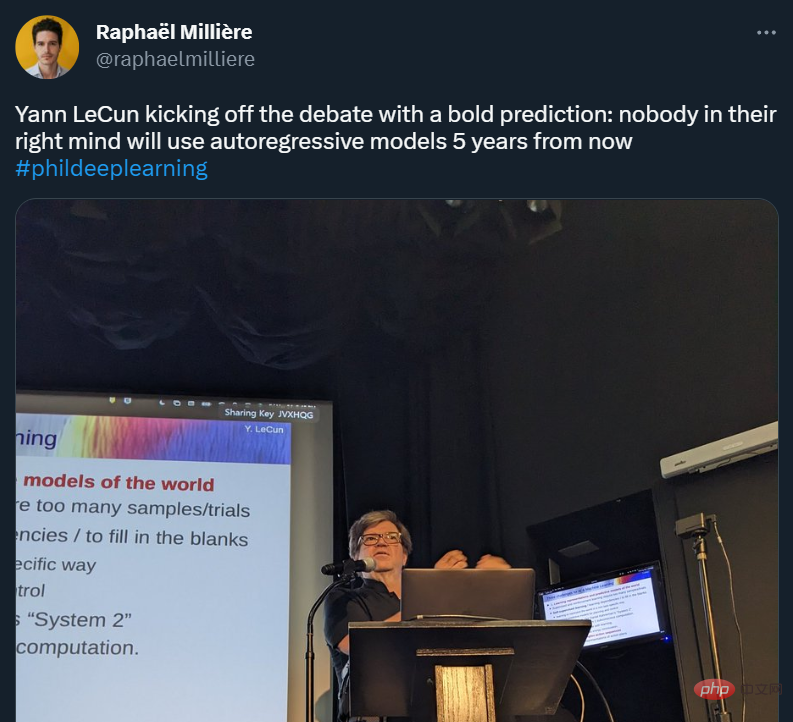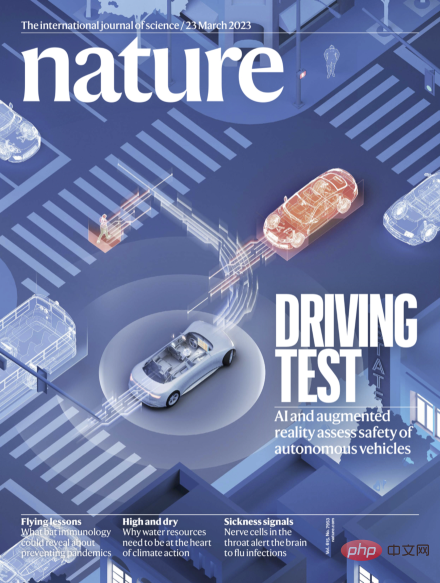 Technology peripherals
Technology peripherals AI
AI Hangzhou boy used Griefbot to 'resurrection' his grandfather. It has been deleted now: he doesn't want to rely too much on AI.
Hangzhou boy used Griefbot to 'resurrection' his grandfather. It has been deleted now: he doesn't want to rely too much on AI.In our photo album, there are photos and videos of our loved ones.
In our social media, there are voice strips of loved ones.
We also have booming AI technology - we and our loved ones have met in another way.
Siren has passed away
In 2020, a young Chinese software engineer in Hangzhou accidentally discovered an article about lip-sync technology.
The mechanism is very simple - a computer program is used to match mouth movements to speech recordings.
He immediately thought of his grandfather who had died ten years ago.
"Can I use this technology to say a few words to my grandfather again?" Yu Jialin asked himself.
In fact, this is not the first time we have tried to use the developed technology to reconstruct our deceased relatives.
With the help of various chat programs, facial recognition AI models, speech recognition, and action recognition models, plus the audio and video data of our loved ones saved, we can try to reproduce Characters and memories of deceased relatives.
Then you can "chat" with them again.
Yu Jialin is 29 years old this year. 12 years ago, his grandfather left him forever.
People always start to regret some things after their loved ones pass away. Yu Jialin remembers that one time his grandfather interrupted a game he was playing and he yelled at his grandfather.
Another time, Yu Jialin told his grandfather not to pick him up from school again.
It was little things like this that made him and his family miss their deceased grandfather so much.
Yu Jialin said that since his grandfather passed away, they have avoided mentioning him. In order not to let sadness occupy themselves, they choose to forget as much as possible.
Griefbot
Now, Griefbot is here.
This is an AI model that has been around for several years, and it can imitate humans by learning the various information we have about our deceased relatives.
But just last year, generative AI suddenly developed explosively, and Griefbot's performance was suddenly pushed to another level.
In the past Griefbot required a lot of data. Now, engineers like Yu Jialin can feed preserved data into this model and accurately recreate how they looked, spoke, and thought.
Foreign researchers say that today’s technology allows AI to reshape a person’s personality without too many samples.
Especially, coupled with systems like ChatGPT - they already have a good understanding of the way most people naturally speak or write.
Researchers said that after inputting the required information and fine-tuning the system, a 99% similarity can be achieved. There are no particularly obvious differences.
With this technology, Yu Jialin returned to his grandmother and found a lot of old letters belonging to his grandfather. The grandfather in the letters was the grandfather Yu Jialin had never met.
At the same time, he also found photos and videos taken by his grandfather more than ten years ago, as well as text messages his grandfather sent him.
Unfortunately, after several weeks of training and debugging, Yu Jialin's programming ability is still limited. It takes about 10 minutes to respond to each question during the interaction.
For example, he asked Griefbot, "Grandpa, guess who I am?"
Bot responded, "Who are you? It’s not important, life itself is a beautiful miracle.”
But giving more information to this Bot can still make the situation much better.
"Happy Teahouse has stopped broadcasting."
Grandpa said, "Yeah, what a pity. This is my favorite thing to watch. program, I originally wanted to watch a few more episodes."
At this point, Yu Jialin feels that this program has become increasingly mature. So, he showed the Bot to his grandma.
Yu Jialin's grandma quietly watched her husband answer her questions on the screen, with a hint of emotion in her eyes.
Yu Jialin said that he believed that this robot would become a good spiritual sustenance for his grandmother.
Faced with the reporter, Yu Jialin said that he did not want to share these conversations that only belonged to himself and his grandfather.
D-ID
In a video on station b, the up owner Wu Wuliu also restored the entire process of "resurrecting" grandma for us.
He first chose Midjourney, the current mainstream AI painting software, to generate a lifelike avatar of his grandma. AI generates some choices based on the uploaded pictures and text descriptions, and the UP owner selects the most realistic one based on the memories in his mind.

Then follow the same pattern and use text to refine certain facial features. Such as wrinkles, eyes, hairstyle and demeanor.
We can see that the current technology can already make the details of the generated avatar perfect.

The next step is audio. Again, these materials come from past phone recordings, video recordings or WeChat voices. Just like Yu Jialin, Wu Wuliu uploaded the audio of his past grandmother’s phone calls to the AI.

After that, he used the video editing software AU to make adjustments. And cut clearer audio samples into short sentences of several seconds to facilitate annotation.
Finally, package the processed audio and put it into the speech synthesis system.

Using the speech synthesis system, Wu Wuliu tried text-to-speech.
Now, the basic materials are complete. The next step is the most critical step - generating virtual digital people.
Through D-ID, users can generate digital virtual people and communicate with them.

Select your avatar on the left and upload text or audio on the right.
The image of grandma on the website is lifelike, and the audio also perfectly restores grandma’s “local accent”. Paired with the homely chat content on the right, it's like having a face-to-face video call with grandma.


What’s interesting is that these “responses” from grandma are also generated by ChatGPT.
Wu Wuliu told ChatGPT, "I miss my grandma very much. Can you imitate her tone to talk to me?"
Artificial intelligence with a human touch is hard not to move people to tears. With the help of memories of her grandmother, Wu Wuliu also tried her best to make ChatGPT more like her grandmother.

The ultimate goal of technology is to provide power to people. This power is not only material, but more importantly, spiritual. Although these chat contents are not completely anthropomorphic, there are also some inappropriate expressions.
But in general, the small details in life can still give people the most tender experience.

Grief sustenance in the new era
An expert in Boston said that with the development of new technology, As time passes, the way people express their grief will certainly change.
In the 1980s, people might write stories about their loved ones to commemorate them. Nowadays, saving electronic data is even more common.
Psychologists often help bereaved clients talk to an empty chair as if their loved one is still sitting in it.
Of course, the new changes brought about by new technologies are not necessarily a good thing.
At that time, Wu Wuliu’s video caused widespread discussion on station b.
The practice of turning deceased relatives into virtual digital beings is still a new thing. The change in perspective is not that easy.
Some netizens said that after all, digital virtual people cannot be the spiritual sustenance of those who commemorate him.
Even, there may be over-reliance on AI.
Because of this, Yu Jialin has deleted the robot that reshaped his grandfather.
He said that he did not want to be overly immersed in the past, let alone holding AI all day long.
The above is the detailed content of Hangzhou boy used Griefbot to 'resurrection' his grandfather. It has been deleted now: he doesn't want to rely too much on AI.. For more information, please follow other related articles on the PHP Chinese website!
 ai合并图层的快捷键是什么Jan 07, 2021 am 10:59 AM
ai合并图层的快捷键是什么Jan 07, 2021 am 10:59 AMai合并图层的快捷键是“Ctrl+Shift+E”,它的作用是把目前所有处在显示状态的图层合并,在隐藏状态的图层则不作变动。也可以选中要合并的图层,在菜单栏中依次点击“窗口”-“路径查找器”,点击“合并”按钮。
 ai橡皮擦擦不掉东西怎么办Jan 13, 2021 am 10:23 AM
ai橡皮擦擦不掉东西怎么办Jan 13, 2021 am 10:23 AMai橡皮擦擦不掉东西是因为AI是矢量图软件,用橡皮擦不能擦位图的,其解决办法就是用蒙板工具以及钢笔勾好路径再建立蒙板即可实现擦掉东西。
 谷歌超强AI超算碾压英伟达A100!TPU v4性能提升10倍,细节首次公开Apr 07, 2023 pm 02:54 PM
谷歌超强AI超算碾压英伟达A100!TPU v4性能提升10倍,细节首次公开Apr 07, 2023 pm 02:54 PM虽然谷歌早在2020年,就在自家的数据中心上部署了当时最强的AI芯片——TPU v4。但直到今年的4月4日,谷歌才首次公布了这台AI超算的技术细节。论文地址:https://arxiv.org/abs/2304.01433相比于TPU v3,TPU v4的性能要高出2.1倍,而在整合4096个芯片之后,超算的性能更是提升了10倍。另外,谷歌还声称,自家芯片要比英伟达A100更快、更节能。与A100对打,速度快1.7倍论文中,谷歌表示,对于规模相当的系统,TPU v4可以提供比英伟达A100强1.
 ai可以转成psd格式吗Feb 22, 2023 pm 05:56 PM
ai可以转成psd格式吗Feb 22, 2023 pm 05:56 PMai可以转成psd格式。转换方法:1、打开Adobe Illustrator软件,依次点击顶部菜单栏的“文件”-“打开”,选择所需的ai文件;2、点击右侧功能面板中的“图层”,点击三杠图标,在弹出的选项中选择“释放到图层(顺序)”;3、依次点击顶部菜单栏的“文件”-“导出”-“导出为”;4、在弹出的“导出”对话框中,将“保存类型”设置为“PSD格式”,点击“导出”即可;
 GPT-4的研究路径没有前途?Yann LeCun给自回归判了死刑Apr 04, 2023 am 11:55 AM
GPT-4的研究路径没有前途?Yann LeCun给自回归判了死刑Apr 04, 2023 am 11:55 AMYann LeCun 这个观点的确有些大胆。 「从现在起 5 年内,没有哪个头脑正常的人会使用自回归模型。」最近,图灵奖得主 Yann LeCun 给一场辩论做了个特别的开场。而他口中的自回归,正是当前爆红的 GPT 家族模型所依赖的学习范式。当然,被 Yann LeCun 指出问题的不只是自回归模型。在他看来,当前整个的机器学习领域都面临巨大挑战。这场辩论的主题为「Do large language models need sensory grounding for meaning and u
 ai顶部属性栏不见了怎么办Feb 22, 2023 pm 05:27 PM
ai顶部属性栏不见了怎么办Feb 22, 2023 pm 05:27 PMai顶部属性栏不见了的解决办法:1、开启Ai新建画布,进入绘图页面;2、在Ai顶部菜单栏中点击“窗口”;3、在系统弹出的窗口菜单页面中点击“控制”,然后开启“控制”窗口即可显示出属性栏。
 ai移动不了东西了怎么办Mar 07, 2023 am 10:03 AM
ai移动不了东西了怎么办Mar 07, 2023 am 10:03 AMai移动不了东西的解决办法:1、打开ai软件,打开空白文档;2、选择矩形工具,在文档中绘制矩形;3、点击选择工具,移动文档中的矩形;4、点击图层按钮,弹出图层面板对话框,解锁图层;5、点击选择工具,移动矩形即可。
 强化学习再登Nature封面,自动驾驶安全验证新范式大幅减少测试里程Mar 31, 2023 pm 10:38 PM
强化学习再登Nature封面,自动驾驶安全验证新范式大幅减少测试里程Mar 31, 2023 pm 10:38 PM引入密集强化学习,用 AI 验证 AI。 自动驾驶汽车 (AV) 技术的快速发展,使得我们正处于交通革命的风口浪尖,其规模是自一个世纪前汽车问世以来从未见过的。自动驾驶技术具有显着提高交通安全性、机动性和可持续性的潜力,因此引起了工业界、政府机构、专业组织和学术机构的共同关注。过去 20 年里,自动驾驶汽车的发展取得了长足的进步,尤其是随着深度学习的出现更是如此。到 2015 年,开始有公司宣布他们将在 2020 之前量产 AV。不过到目前为止,并且没有 level 4 级别的 AV 可以在市场


Hot AI Tools

Undresser.AI Undress
AI-powered app for creating realistic nude photos

AI Clothes Remover
Online AI tool for removing clothes from photos.

Undress AI Tool
Undress images for free

Clothoff.io
AI clothes remover

AI Hentai Generator
Generate AI Hentai for free.

Hot Article

Hot Tools

Dreamweaver Mac version
Visual web development tools

MantisBT
Mantis is an easy-to-deploy web-based defect tracking tool designed to aid in product defect tracking. It requires PHP, MySQL and a web server. Check out our demo and hosting services.

Notepad++7.3.1
Easy-to-use and free code editor

SAP NetWeaver Server Adapter for Eclipse
Integrate Eclipse with SAP NetWeaver application server.

SublimeText3 Mac version
God-level code editing software (SublimeText3)






